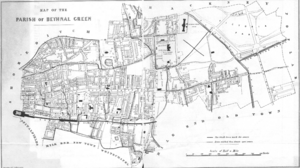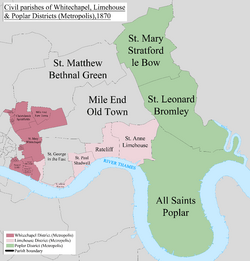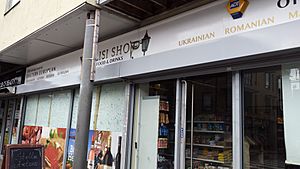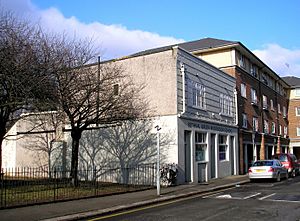Bethnal Green facts for kids
Quick facts for kids Bethnal Green |
|
|---|---|
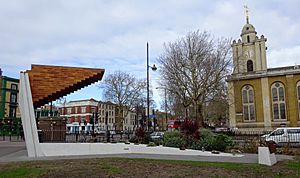 Stairway to Heaven, also seen is Bethnal Green tube station, CoE St John Church and Salmon and Ball public house. |
|
| Population | 27,849 (Bethnal Green North and Bethnal Green South wards 2011) |
| OS grid reference | TQ345825 |
| • Charing Cross | 3.3 mi (5.3 km) SW |
| London borough | |
| Ceremonial county | Greater London |
| Region | |
| Country | England |
| Sovereign state | United Kingdom |
| Post town | LONDON |
| Postcode district | E1, E2 |
| Dialling code | 020 |
| Police | Metropolitan |
| Fire | London |
| Ambulance | London |
| EU Parliament | London |
| UK Parliament | |
| London Assembly | |
Bethnal Green is an area in London, England and is located in the London Borough of Tower Hamlets. It is in east London and part of the East End. The area emerged from the small settlement which developed around the Green, much of which survives today as Bethnal Green Gardens, beside Cambridge Heath Road. By the 16th century the term applied to a wider rural area, the Hamlet of Bethnal Green, which subsequently became a Parish, then a Metropolitan Borough before merging with neighbouring areas to become the north-western part of the new Tower Hamlets.
Economic focus shifted from mainstream farming produce for the City of London – through highly perishable goods production (market gardening), weaving, dock and building work and light industry – to a high proportion of commuters to city businesses, public sector/care sector roles, construction, courier businesses and home-working digital and creative industries. Identifiable slums in the maps of Booth in Life and Labour of the People in London (3 editions, 1889–1903) were in large part cleared before the aerial bombardment of the Second World War which accelerated clearance of many tightly packed terraces of small houses to be replaced with green spaces and higher-rise social housing.
Contents
Toponymy
The topographer Daniel Lysons suggested in the late 18th century that Bethnal was a corruption of Bathon Hall which would have been the residence of a notable Bathon family who owned large parts of Stepney, the parish of which Bethnal Green was part. "Green" related to one which lay "about half a mile beyond the suburbs".
More recently it has been suggested that the name could be a derivation of the Anglo-Saxon Blithehale or Blythenhale from the 13th century. healh would have meant "angle, nook, or corner" and blithe would have been the word for "happy, blithe", or come from a personal name Blitha. In either case, the Dictionary of London Place Names supports a contraction involving hall or healh, noting h-dropping in local dialects, to Bethnal Green.
History
Toponymy
The place-name Blithehale or Blythenhale, the earliest form of Bethnal Green, is derived from the Anglo-Saxon healh ("angle, nook, or corner") and blithe ("happy, blithe"), or from a personal name Blitha. Nearby Cambridge Heath (Camprichesheth), is unconnected with Cambridge and may also derive from an Anglo-Saxon personal name. The area was once marshland and forest which, as Bishopswood, lingered in the east until the 16th century. Over time, the name became Bethan Hall Green, which, because of local pronunciation as Beth'n 'all Green, had by the 19th century changed to Bethnal Green.
Early history
A Tudor ballad, the Blind Beggar of Bethnal Green, tells the story of an ostensibly poor man who gave a surprisingly generous dowry for his daughter's wedding. The tale furnishes the parish of Bethnal Green's coat of arms. According to one version of the legend, found in Thomas Percy's Reliques of Ancient English Poetry published in 1765, the beggar was said to be Henry, the son of Simon de Montfort, but Percy himself declared that this version was not genuine. The Blind Beggar public house in Whitechapel is reputed to be the site of his begging.
Boxing has a long association with Bethnal Green. Daniel Mendoza, who was champion of England from 1792 to 1795 though born in Aldgate, lived in Paradise Row on the western side of Bethnal Green for 30 years. Since then numerous boxers have been associated with the area, and the local leisure centre, York Hall, remains notable for presentation of boxing bouts.
In 1841, the Anglo-Catholic Nathaniel Woodard, who was to become a highly influential educationalist in the later part of the 19th century, became the curate of the newly created St. Bartholomew's in Bethnal Green. He was a capable pastoral visitor and established a parochial school. In 1843, he got into trouble for preaching a sermon in which he argued that The Book of Common Prayer should have additional material to provide for confession and absolution and in which he criticised the "inefficient and Godless clergy" of the Church of England. After examining the text of the sermon, the Bishop of London condemned it as containing "erroneous and dangerous notions". As a result, the bishop sent Woodard to be a curate in Clapton.
The Green and Poor's Land
The Green and Poor's Land is the area of open land now occupied by Bethnal Green Library, the V&A Museum of Childhood and St John's Church, designed by John Soane. In Stow's Survey of London (1598) the hamlet was called Blethenal Green. It was one of the hamlets included in the Manor of Stepney and Hackney. Hackney later became separated.
In 1678 the owners of houses surrounding the Green purchased the land to save it from being built on and in 1690 the land was conveyed to a trust under which it was to be kept open and rent from it used for the benefit of poor people living in the vicinity. From that date, the trust has administered the land and its minute books are kept in the London Metropolitan Archives.
Bethnal House, or Kirby's Castle, was the principal house on the Green. One of its owners was Sir Hugh Platt (1552–1608), author of books on gardening and practical science. Under its next owner it was visited by Samuel Pepys.
In 1727 it was leased to Matthew Wright and for almost two centuries it was an asylum. Its two most distinguished inmates were Alexander Cruden, compiler of the Concordance to the Bible, and the poet Christopher Smart. Cruden recorded his experience in The London Citizen Grievously Injured (1739) and Smart's stay there is recorded by his daughter. Records of the asylum are kept in the annual reports of the Commissioner in Lunacy. Even today, the park where the library stands is known locally as "Barmy Park".
The original mansion, the White House, was supplemented by other buildings. In 1891 the Trust lost the use of Poor's Land to the London County Council. The asylum reorganised its buildings, demolishing the historic White House and erecting a new block in 1896. This building became the present Bethnal Green Library. A history of Poor's Land and Bethnal House is included in The Green, written by A.J. Robinson and D.H.B. Chesshyre.
Other houses on the Green
The north end of the Green is associated with the Natt family. During the 18th century they owned many of its houses. Netteswell House is the residence of the curator of the Bethnal Green Museum. It is almost certainly named after the village of Netteswell, near Harlow, whose rector was the Rev. Anthony Natt. A few of its houses have become University settlements. In Victoria Park Square, on the east side of the Green, No. 18 has a Tudor well in its cellar.
Representation
Excluding the five-year tenure of George Galloway at Westminster from 2005, for any seat containing the name Bethnal Green: the pre-1945 General Election decades of Bethnal Green South West was the last time when such a seat was not won by the chosen Labour Party candidate.
Bethnal Green forms part of the UK Parliament constituency of Bethnal Green and Bow. Its MP since 2010 has been Rushanara Ali of the Labour Party.
London overall has a directly elected executive Mayor of London, currently Sadiq Khan, and the City and East seat in the London Assembly is held by the Labour Party member, Unmesh Desai.
The area of Bethnal Green covers roughly three wards of Tower Hamlets; Bethnal Green represented by Councillors Mohammed Ahbab Hossain, Sirajul Islam (who is Statutory Deputy Mayor for Housing under Mayor of Tower Hamlets and Eve McQuillan; St Peter's (which takes its name from the ecclesiastical parish of the same name) represented by Councillors Kevin Brady, Tarik Khan and Gabriella Salva-Macallan; and Weaver's represented by Councillors John Pierce and Abdul Mukit All local councillors are currently members of the Labour Party.
Between 1986 and 1992, the name Bethnal Green was applied to one of seven neighbourhoods to which power was devolved from the council. This resulted in replacement of much of the street signage in the area that remains in place.
Cityscape
Conservation Areas
Bethnal Green has a number of conservation areas established by Tower Hamlets Council due to its history and landscape, including the Bethnal Green Gardens Conservation Area which was designated in July 1969 and then extended in October 2008 to the south west of the tube station due to significant buildings located in and around the junction of Bethnal Green Road, Roman Road and Cambridge Heath Road, which helps ensure these landmarks will be preserved.
A part of the Hackney Road Conservation Area is intended to protect the special architectural and historic character of buildings and areas adjoining the road which are composed of a dense concentration of modest sized properties. The Victoria Park Conservation Area was designated in March 1977, altered in 2008 to make way for the Regent's Canal Conservation Area and to expand Driffield Road Conservation Area and now includes the listed park itself, the formal axial road pattern to the south west and the many Victorian terraces.
It is also part of the wider Regents Canal Conservation Area, the streetside buildings are neglected but form part of the industrial heritage and character of Vyner Street and also Wadeson Street, which contains a row of three storey Victorian workshops mostly converted to residential use. Both types contribute to the character of the area.
To the north-west is the Old Bethnal Green Road Conservation Area, which focuses around the roads of the Winkley Estate, which has a very cohesive character and little scope exists for change. The buildings contained within the area being considered form an important group worthy of protection and enhancement.
Parks
Bethnal Green Gardens, located in central Bethnal Green, holds the war memorial, known as the Stairway To Heaven, and Weavers' Fields, which is a 15.6 acres park and is the 6th largest open space in Tower Hamlets that lies south of Bethnal Green Road. The western part of Victoria Park is in Bethnal Green.
In the 1970s, Tower Hamlets Council decided to fence and lock up the area now known as Bethnal Green Nature Reserve, to protect it from fly tipping. In the late 1990s the local Teesdale and Hollybush Tenants and Residents Association became the site custodians and, with the support of Tower Hamlets Council, took responsibility for St Jude's as it was still called locally.
Notable buildings
The former Bethnal Green Infirmary, later the London County Council Bethnal Green Hospital, stood opposite Cambridge Heath railway station. The hospital closed as a public hospital in the 1970s and was a geriatric hospital under the NHS until the 1980s. Much of the site was developed for housing in the 1990s but the hospital entrance and administration block remains as a listed building.
Demographics
Bethnal Green had a total population of 27,849 at the 2011 UK census. The largest single ethnic group is people of Bangladeshi descent, who constitute 38 per cent of the area's population. Every year since 1999 the Baishakhi Mela is held in Weavers' Fields to commemorate the Bengali New Year. The second largest is the White British, constituting 30 per cent of the area's population. Other ethnic groups include Black Africans and Black Caribbeans.
According to the UK census of 2011, the population has a lower proportion of young people than the national average and a higher proportion of older people. Bethnal Green also has a significant immigrant population.
Religion and mysticism
Bethnal Green's residents are around 50 per cent Muslim and 34 per cent Christian.
There are many historic churches in Bethnal Green. Notable Church of England churches include St John on Bethnal Green, which was built from 1826 to 1828 by the architect John Soane, St Matthew – built by George Dance the Elder in 1746. St Matthew is the mother church of Bethnal Green; the church's opening coincided with a vast population increase in the former village of Stepney, resulting in the need to separate the area around Bethnal Green from the mother Parish of St Dunstan's, Stepney. All but the bell tower, still standing today, was destroyed by fire and the church again suffered devastating damage during the bombing campaigns of the Second World War, resulting in the installation of a temporary church within the bombed-out building. St. Matthew's remains a major beacon of the local East End community and is frequented on Sundays and other religious occasions by a mixture of established locals and more recent migrants to the area. Other churches include St Peter's (1841) and St James-the-Less (1842), both by Lewis Vulliamy, St James the Great by Edward Blore (1843) and St Bartholomew by William Railton (1844). The church attendance in Bethnal Green was 1 in 8 people since 1900 (only 10% attend regularly in the UK). Baptisms, marriages and burials have been deposited nearly at all churches in Bethnal Green.
There is one major Roman Catholic church, the Church of Our Lady of the Assumption, in Bethnal Green. The Church of Our Lady of the Assumption hosts the London Chinese Catholic Centre and Chinese mass is held weekly. Other Christian churches include The Good Shepherd Mission, The Bethnal Green Medical Mission, The Bethnal Green Methodist Church. The Quakers hold regular meetings in Old Ford Road. Opened and named after the parish of Bethnal Green, in 1868, the Bethnal Green Methodist Church became tied in with the founding of the National Children's Home and Orphanage (now Action for Children). This was established next to the church on Bonner Road.
St. Casimir's Lithuanian Church serves London's Lithuanian community and masses are held in both Lithuanian and English.
There are at least eight Islamic mosques or places of worship in Bethnal Green for the Muslim community. These include the Baitul Aman Mosque and Cultural Centre, Darul Hadis Latifiah, the Senegambian Islamic Cultural Centre and the Globe Town Mosque and Cultural Centre.
The London Buddhist Centre works with those affected by alcohol dependency, the centre also runs courses and retreats using mindfulness based cognitive therapy approaches. Its courses for depression, based on the mindfulness-based cognitive behavioral therapy methodology of Jon Kabat-Zinn at the University of Massachusetts Medical School, featured in the Financial Times in 2008. It is the focus of a large Buddhist residential and business community in the area.
In the Boundary Estate, Arnold Circus is a mark point on several ley line alignments, such as for example the Alfred Watkins' "Strand Ley" and "The Coronation Line".
Public Services
Education
Bethnal Green has numerous primary schools, educating children aged four to 11. St. Matthias School, on Bacon Street off Brick Lane, is over a century old and uses the Seal of the old Metropolitan Borough as its badge and emblem. The school was opened with funds from 18th-century St. Matthew's Church on St. Matthew's Row. The Bangabandhu Primary School, named after the father of Bangladesh, Sheikh Mujib, a non-selective state community school, was opened in January 1989; it moved to a new building in November 1991 and has over 450 pupils. In the first decade, around 70% of pupils' parents spoke English as a second language; instead speaking Sylheti, a dialect of Bengali, at home, and Standard Bengali is a subject choice in the school.
Bethnal Green Academy is one of the top schools and sixth form colleges in London. Other schools in the area include Oaklands School.
The oldest secondary school was Raine's Foundation School on Old Bethnal Green, a voluntary aided, Anglican-tradition, state school founded in 1719. The school relocated, amalgamating with St. Jude's School to become coeducational in 1977. The school closed in 2020.
Bethnal Green Gardens and Bethnal Green Library provide leisure facilities and information.
Voluntary and community services
The Oxford House is a proactive community centre that has its roots in helping the local community. Founded in 1884, as one of the first "settlements" by Oxford University, it has helped alleviate or remove the impact of poverty and today still remains a focus point by providing a programme of community classes, events and weekly activities.
The Approach Gardens, once an unused space, has been developed into a community food garden, a shared fruit orchard and a wildlife area.
The Nomadic Community Gardens, once an area fenced off and overgrown, was occupied between 2015 and 2019 by a temporary project or "meanwhile use" run by a private limited company on behalf of the property developer Londonewcastle, which leases the site to the garden operator for a peppercorn rent and provided start-up funding. Londonewcastle gained planning consent for a development of "affordable housing, townhouses and apartments" on the site in November 2015. Construction on the Fleet Street Hill Project was intended to commence in 2016. In 2019 ownership of the lease was sold; the site currently remains empty.
The Gallery Cafe, in St. Margaret's House, reopened as a vegetarian not-for-profit, community café in 2006; it became a fully vegan café in December 2017. It won Best Café in Bethnal Green at the Time Out Love London Awards in 2014, 2015 and 2016.
Transport
Railway
Bethnal Green tube station is on the London Underground Central line, which connects Bethnal Green directly to Stratford in the east, the City and London's West End.
The area is also linked to the National Rail network at two stations on the London Overground network: Bethnal Green and Cambridge Heath railway stations.
In 2018, Cambridge Heath station was chosen for a trial with a pay-by-face system that may end the need for station barriers, due to its low passenger volumes and having no gates.
Bethnal Green has also been part of the Night Tube service since 2016.
Buses
Bethnal Green is served by London Buses, including route 8, 26, 55, 254 and 388 to Central London; routes 309, 388, D3, D6 and night routes N8, N26, N55 and N243 also stop here.
The 26 bus route was introduced in 1992 to replace the withdrawn section of route 6 between Hackney Wick and Aldwych and included a new night counterpart to Chingford from Hackney Wick, the N26.
On 25 September 1993, route 309 started running between Bethnal Green and Poplar. It was intended to start from the London Chest Hospital but this was delayed due to speed hump problems and it therefore started and ended at Three Colts Lane instead. It was finally extended from Bethnal Green station to Chest Hospital in 1995.
Art and memorials
Clare Street is well known as an art quarter. Some of the murals there have the buildings' owners' permission. Elsewhere, a mural of David Attenborough appeared on the side of a tropical fish store on St Matthew's Row.
Chris Gollon gained a major commission from the Church of England for fourteen Stations of the Cross paintings for the St John church. Gollon was a controversial choice, since he is not a practising Christian. In order to carry out the commission, and for consultation on theological matters, he collaborated with Fr Alan Green, Rector of the church.
Between 2005 and 2008, the EEL (East End Life) established the Vyner Street Festival with the local Victory Pub as a family festival with local bands, artists and market traders, this has a different theme every year, with the Red Arrows performing flyover in 2008. By 2012, however, many artists had moved out due to the effects of the Great Recession as well as the 2012 Olympics. A documentary film was released in the same year titled Vyner Street: this was a short observational piece about two different worlds living inconspicuously and side by side in the same place.
As part of "TUBE" Art Installation in November 2013, sound artist Kim Zip created an installation commemorating the Bethnal Green Tube Disaster. The work was backed by the Whitechapel Gallery and promoted as part of the organisation's "First Thursdays" initiative for popular art. "TUBE" exhibited over a period of four weeks in the belfry of Sir John Soane's St John on Bethnal Green Church. The Lady Dinah's Cat Emporium was the first cat café in London, which was opened in 2013.
The Oval Space hosted Catfest in 2018, with guests having the chance to take photos with cats as well as sample street food and meet shelter kittens.
A plaque was placed at the entrance to the tube station in the 1970s to commemorate the disaster there, one of the worst of the Second World War; and a larger memorial, "Stairway to Heaven", stands in nearby Bethnal Green Gardens. This memorial was unveiled in December 2017 at a ceremony attended by Mayor of London Sadiq Khan and Bethnal Green and Bow MP Rushanara Ali.
Employment and gentrification
In 2019 Sustrans opened a new London headquarters at Bethnal Green.
Early in 2018 Frank Wang, who had sold coffee to commuters from his van at the northern exit of Bethnal Green underground station lost his business when the electricity supply from the station was cut off as a result of the nearby site of a disused public lavatory behind his stall being converted into a beach bar called Chiringuito. Tower Hamlets Mayor John Biggs, one of Frank's long-standing customers came out in support along with the local community, the Chinese community and commuters who protested.
Formerly part of the estate of Truman's Brewery, now a free house, The Hare was cited as the epitome of a 'good, honest pub' by the Evening Standard and was listed as one of the 50 best pubs in London in 2019. During the May bank holiday, the redeveloped railway arches off Cambridge Heath Road into an eating and drinking quarter opened. Tower Hamlets Council had turned down plans for the Cambridge Heath Road development because of concerns over its affordable housing mix and design quality. The Better Streets for Tower Hamlets had turned the car park spot in Bethnal Green Road into a mini park for a day to draw people's attention to the need for more healthier public spaces.
In 2018 Sainsbury's opened what it claims was the country's first meat-free butchers, in the form of a traditional style butchers which was open for three days from Friday 21 June to mark World Meat Free Week, where it offered customers an array of cuts and joints derived from plant-based alternatives, such as mushroom, jackfruit and pea protein. During the 2019 redecorating of the Carpenters Arms on Cheshire Street, an old safe was found in the cellar when a wall was torn down. It is thought it was boarded up before the immediately previous owners has acquired the pub.
Notable people
- Cheryl Baker, singer and television presenter
- Shamima Begum, a British-Bangladeshi woman who went to marry an ISIL member
- Roger Crab (1621–1680), a promoter of Christian vegetarianism, who lived as a hermit at Bethnal Green.
- Pete Doherty and Carl Barât of the Libertines lived and performed gigs in a flat at 112a Teesdale Street in Bethnal Green they called The Albion Rooms.
- Leslie Fuller, nationally famous film star (One Good Turn), once lived at 14, Pollard Row.
- Peter Green (1946-2020), blues guitarist and founding member of rock group Fleetwood Mac
- Joseph Merceron (1764–1839), a corrupt property developer and magistrate.
Sport
- Men's association football
Non-League football clubs are:
- Tower Hamlets FC
- Sporting Bengal United FC
Both play at Mile End Stadium.
See also
 In Spanish: Bethnal Green para niños
In Spanish: Bethnal Green para niños



